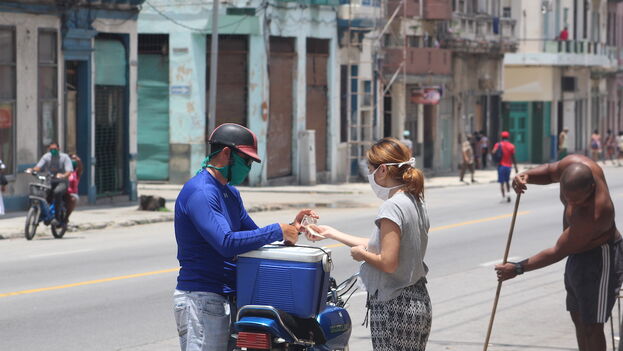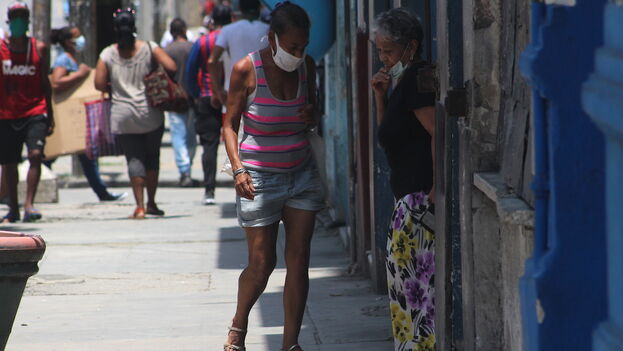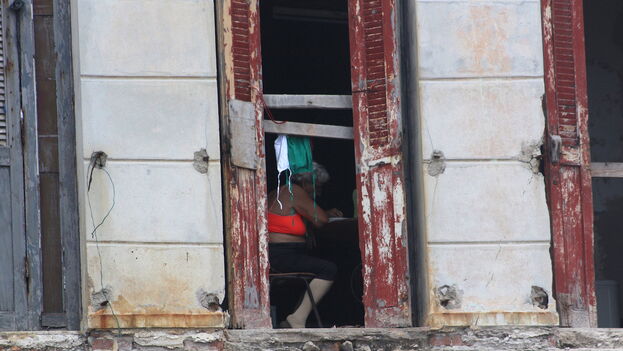
![]() 14ymedio, Luz Escobar, Havana, May 28, 2020 — They haven’t seen each other for a long time. First they wave from across the street but then begin walking towards each other. Keeping their distance, the two friends exchange greetings by bumping elbows together. Without removing their face masks, they talk for a few minutes under the sun on San Lazaro Street.
14ymedio, Luz Escobar, Havana, May 28, 2020 — They haven’t seen each other for a long time. First they wave from across the street but then begin walking towards each other. Keeping their distance, the two friends exchange greetings by bumping elbows together. Without removing their face masks, they talk for a few minutes under the sun on San Lazaro Street.
A stroll through Central Havana reveals how many routines, both large and small, have changed since coronavirus arrived on the island.
“My daughter turns fifteen next year. She used to hate talking on the phone but now she spends all day glued to it, chatting with her friends,” says 45-year-old Alicia Pineda. This new pastime that her daughter has acquired since confinement began has translated into a heftier phone bill for Pineda.

“The bill from Etesca usually isn’t more than 20 Cuban pesos but this month it was 114. I understand why. She’s very bored and misses going out and seeing the neighborhood boys. But I have been very strict with her. Since classes were cancelled, she hasn’t even been to the corner. I don’t have the luxury of one of us endng up in the hospital,” she explains.
The only things increasing are her expenses. Food, on the other hand, is shrinking. “Everything has become very difficult. Nobody helps out much around here. Most of the work load is on my shoulders. Since this pandemic began, we haven’t had meat on a daily basis, something that used to be a given for us,” she laments.
Alicia Pineda talks as she takes out the rationed beans she bought at the market. At the window sill, with the little light coming in from the terrace, she thinks about what else she can put on the table to feed her large family. Today she only has the beans and some ground meat which, she says, she can stretch over two or three meals.
“There’s no more rice now either. By this time of the month I always have to make ends meet by shopping on the free [unrationed] market but now there’s nothing to be found. People are obsessed with finding food and I cannot stand in line for five hours,” adds Pineda, who lives in a small apartment with her teenage daughter, her grandparents, two older aunts and three cousins. “And since nobody goes outside, we spend all day annoying each other, looking at each other’s faces. It’s unbearable.”
On the other side of the street two boys play by splashing a stagnant puddle with a stick. They are barefoot and neither of them wears a shirt or mask. The scene is out of the ordinary, more like an image from a pre-pandemic past.
“The boys haven’t handled the change of routine well. They used to spend the day playing in the park. That’s why I don’t say anything when they go outside,” says their mother, whose sons are five and eight.
“I was looking forward to going back to work once the little one started school in September. But suddenly everything changed and I didn’t even have time to look for a job. I’m stubborn. I spend the day washing, cooking, organizing, scrubbing. This has to end soon or I’m going to go crazy,” says the 26-year-old, exasperated after having her children at home twenty-four hours a day.
“But not everyone has it so bad,” she acknowledges. “My neighbor upstairs has family overseas who religiously send her remittances every month. Almost every day she orders food delivered to her door. Sometimes she pays for it here but other times her family pays it from over there. It’s great but I can’t afford that luxury. All day long you can see motorcycles from the businesses on this street coming and going.” Another example of how having a family overseas defines social class on the island.

San Lazaro Street, normally abuzz with activity from cafes and small businesses, is now a desert. Only three places are still operating, though with some changes in routine. On Thursday one of them was offering a plate of pork liver with rice, vegetable and salad for 40 Cuban pesos. The same combination with chicken or pork was going for 50 and 60 pesos.
“We can’t let customers eat in here like before. Now we only sell takeout because we aren’t going to risk getting fined for helping spread the pandemic. And it’s not easy to get supplies either. We have to perform magic just to stay open. That’s why prices have gone up. We have to work twice as hard and spend more money to get the basic necessities or we would have to close,” notes one of the employees as he serves a customer a glass of mango juice.
A 50-year-old man approaches the counter, lowers his mask, looks left and right to make sure no one sees him without his face covering, and takes a sip of his juice. “Would anyone have told me I would be paying ten pesos for a glass of mango juice?” he asks.
________________
COLLABORATE WITH OUR WORK: The 14ymedio team is committed to practicing serious journalism that reflects Cuba’s reality in all its depth. Thank you for joining us on this long journey. We invite you to continue supporting us by becoming a member of 14ymedio now. Together we can continue transforming journalism in Cuba.
